There are 32 good companion plants for sweet potatoes in this list along with 10 plants you should avoid. They include a variety of plants such as alliums, brassicas, flowers, herbs, and more.
If you want to plant sweet potatoes in your garden, you will need to know what to plant near them and what to avoid growing in the same area. Keep reading to know more about good and bad companion plants for sweet potatoes.
Not to be confused with regular potatoes, sweet potatoes are flowering plants belonging to Convolvulaceae, the morning glory family. This plant and the regular potato are only related by order: they both belong to the order Solanales.
Sweet potatoes produce large, starchy and tasty root tubers which are mostly eaten as root vegetables. About 76% of this vegetable is water, 21% carbohydrates, 2% protein and trace amounts of fat.
It supplies vitamins A equivalent, B1 (thiamine), B2 (riboflavin), B3 (niacin), B6, B9 (folate), C and E, and the minerals calcium, iron, magnesium, manganese, potassium, phosphorus, sodium and zinc to the body.
Sweet potatoes contain lots of fiber, vitamins and minerals so they are healthy additions to one’s diet. They also provide aid to the immune system, encourage good eyesight, promote digestive health and improve brain function.
Table of Contents
For the best results when planting this vegetable, grow it in a spot where it will receive full, direct sunlight daily. Maintain consistent soil moisture levels especially in its establishment and root develomw periods.
Plant it in light, sandy soil rich in organic matter for the best results. The soil could also be fine loamy soil and should be well draining, loose, with slightly acidic pH of 5.5 to 6.5.
Sweet potatoes are prone to pest infestation and diseases. They may be attacked by aphids, click beetles, Colorado potato beetles, cutworms, flea beetles, root-knot nematodes, slugs, spider mites, potato leafhoppers, thrips, weevils, whiteflies and others.
There are however several other crops which may be planted with them in your garden to encourage their growth, help keep pests away, attract useful insects, replenish soil nutrients and provide ground cover or shade from sunlight.
Such grouping for the purpose of sharing benefits is called companion planting. It is a tried and true method, ensuring for years that crops are grown with some other crops that help them grow healthy.
In this article, you will learn about thirty-two (32) good and ten (10) bad companion plants for spinach in your garden. Also explained below are reasons why they are or are not ideal beside your plant.
Good Companion Plants for Sweet Potatoes
Alliums
1. Chives
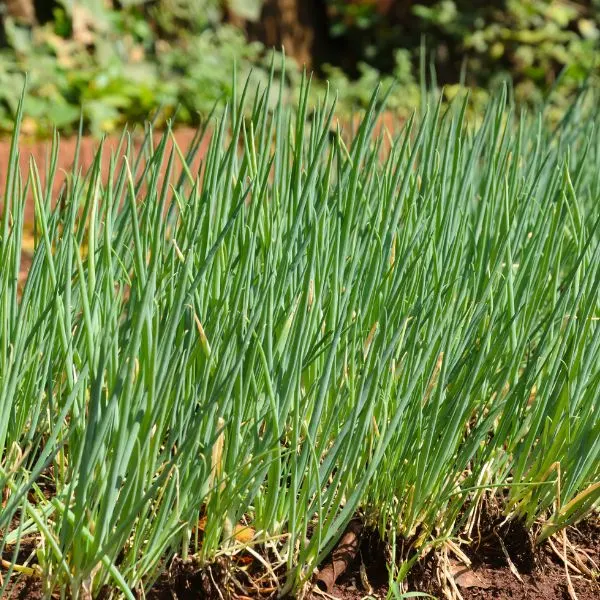
Chives, with their aromatic properties, serve as an excellent companion plant for sweet potato vines, deterring pests and enhancing the sweet taste of the tubers come harvest time.
Like other alliums, they are good companions for sweet potatoes in the garden for their effectiveness at controlling pests. Chives and other alliums contain sulfur, the natural antifungal and antibacterial compound.
Chives help control weevils and flea beetles, as they also deter root-knot nematodes. They also have stunning purple-pink flowers that attract insects to aid pollination and control pests.
They can also prevent soil erosion. Their dense roots help your soil stay in place but they spread very fast. Consider using a physical barrier in the soil to make sure the chives are not detrimental to your sweet potatoes.
2. Garlic
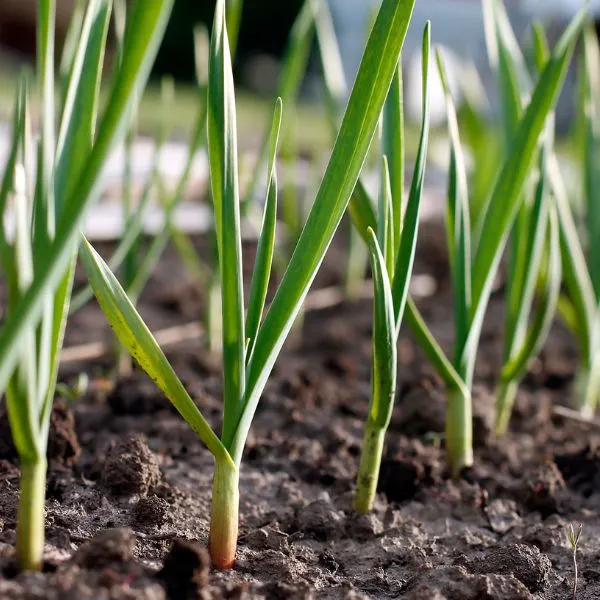
Garlic is another plant in the genus Allium. The flowering plant has a pungent bulb divided into cloves which is used to season food or make an oil sprayed to deter pests.
It is a very good companion plant for sweet potatoes. Because it contains sulfur, the allium has a strong smell and can prevent the infestation of pests, fungal diseases and bacterial infections.
It is especially known for its ability to reduce the activity of root-knot nematodes and flea beetles. Also, garlic is said to improve the flavor of sweet potatoes and other garden veggies if they are grown side by side.
3. Leeks
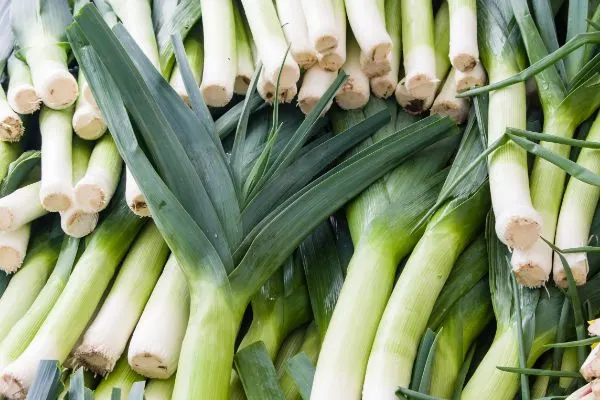
The leek is another flowering plant within the genus Allium. It possesses a large and slender white bulb and flat dark green leaves that overlap. Like other pungent members of its family, it is used in cooking.
Leeks are also good companion plants for sweet potatoes. They can help to repel some natural predators of the plants, like aphids, flea beetles, deer, rabbits and other foraging rodents.
Their sulfur content lends them their pungent smell and their sharp, stinging taste. It also prevents root knot. The flowers of leeks also attract pollinators to help your sweet potatoes reproduce.
4. Onions
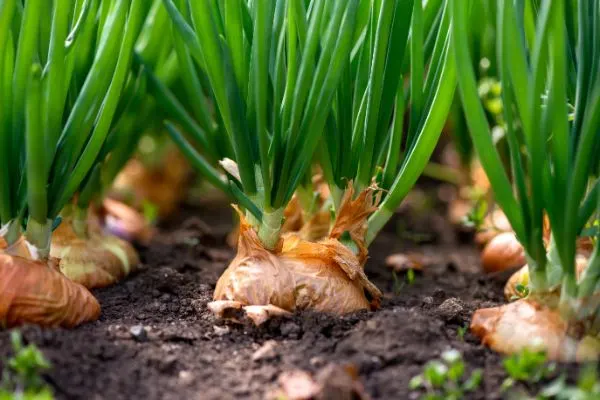
An onion is a flowering plant in the genus Allium with bluish green leaves and a bulb at its base. This bulb is made up of shortened underground stems and fleshy modified leaves. Onion is the most widely cultivated vegetable in its genus.
Onions are able to deter several pests like aphids, beetles, deer, rabbits, weevils and whiteflies because they have natural fungicidal properties that can help protect sweet potatoes from root knot.
The roots of onion plants also break up tough clumps of soil and give your sweet potato space to grow in the soil. They also have flowers that attract beneficial insects to the garden.
5. Scallions

Scallions or green onions are a species in the genus Allium. They are typically milder in taste than other alliums and lack a fully developed bulb. Their hollow, tubular leaves are eaten cooked or raw as a vegetable.
Like other members of their genus, scallions aid pest control, they may improve the flavor of sweet potatoes and the other plants around them, and they attract various useful animals like pest predators and pollinators.
Brassicas
Brassicas, known for their resilience to pests such as the potato blight, make a great addition to your sweet potato patch, especially in regions with long growing seasons and dry seasons under the hot sun.
6. Beets

Beets are flowering brassicas that produce an edible and usually deep red taproot known as beetroot. Their leaves, known as beet greens, may be eaten as vegetables. They are good companion plants for sweet potatoes.
Like sweet potatoes, beets are root vegetables but while beets are heavy feeders, sweet potatoes need or require much less mineral nutrients than beets do for optimal growth and improved yield.
These plants do not inconvenience each other in terms of nutrient needs, beets can help reduce the infestation of pests on your sweet potatoes, and both plants can attract beneficial insects to the garden.
7. Broccoli
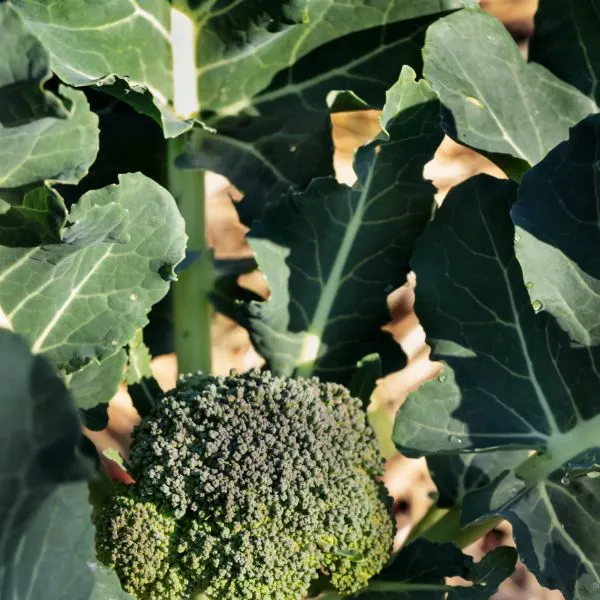
Broccoli is a flowering plant in the family Brassicaceae, the cabbage family. It has large, partly developed green flowers that make up its head, stalks and leaves which are the edible parts of the plant.
Broccoli and some other brassicas are good companion plants for sweet potatoes because they naturally go well with each other without causing any harm. These plants need different nutrients for optimal growth.
In addition to the fact that they do not compete for nutrients, both of these plants bear flowers. Growing them together can attract pollinators and other beneficial insects to that area of your garden.
8. Brussels Sprouts
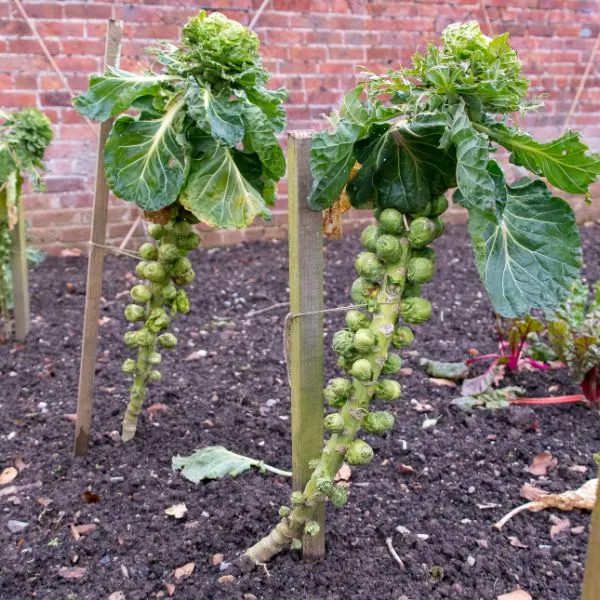
Another brassica that serves as a good companion for sweet potatoes is Brussels sprout. Brussels sprouts are flowering plants in the cabbage family grown for their edible buds. They are green leafy vegetables resembling very small cabbages.
As flowering plants, both Brussels sprout and sweet potato attract insects and animals to the garden to help with the reproductive process of pollination. While sweet potatoes are moderate feeders, Brussels sprouts are heavy feeders.
However, Brussels sprouts also fix nitrogen in the soil. It will be beneficial to add plants that attract pest predators or repel common plant pests to the companionship.
9. Cabbage

Cabbage is a flowering biennial plant mostly grown as a vegetable crop for its edible and tightly packed leaves. Its leaves are layered and may be white, red or green. This is another good companion plant for sweet potatoes.
It releases biotoxins that work against several soil borne pathogens. The toxins work against root knot nematodes and keep your root veggie healthy as they show activity against bacteria, nematodes and fungi.
They are also active against several weeds. Cabbages also provide good ground cover and by doing so they help control erosion and the growth or spread of weeds.
10. Cauliflower

Cauliflower is another flowering plant in the Brassicaceae family, cultivated for its partially developed flowers, referred to as the head or “curd”. The head is edible and mostly in the colors white, yellow, green, orange, brown or purple.
Just as some other brassicas go well with sweet potatoes in the garden bed, cauliflower also makes a great companion for this vegetable f. It can help with some amount of pest control while serving as ground cover.
Some brassicas inconsistently release chemical compounds called biotoxins that may be toxic to soil borne pathogens, pests and weeds. Cauliflower captures nitrogen in the soil and helps to control erosion by providing good ground cover.
11. Kale
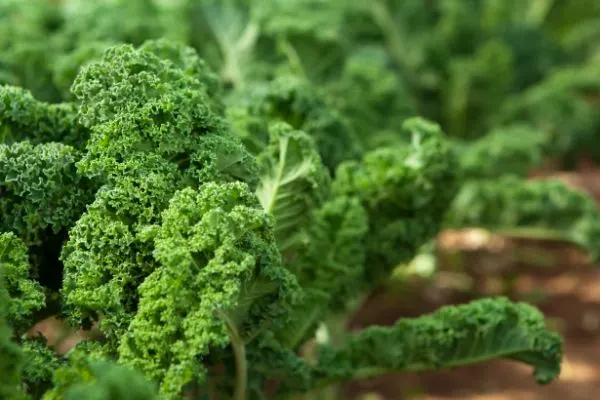
Another brassica that serves as a good companion plant for sweet potatoes is kale. Kale, also called leaf cabbage, is a flowering plant with edible green or purple leaves that do not form a central head. Its leaves may be eaten or ornamental.
Kale provides ground cover and aids pest control. It releases some amounts of biotoxins which may be toxic to several pathogens and pests that live in the soil. This means kale helps protect sweet potatoes from fungi, nematodes and some weeds.
It helps curbs the problems of erosion and weeds which are some consequences of having open soil in your garden. Kale can capture nitrogen remaining in the soil after harvest, and this nutrient is very important for plant development.
12. Kohlrabi

Kohlrabi is a cultivar of wild cabbage, also known as German turnip. This vegetable has edible leafy greens, thin stems and yellow flowers. It is nearly spherical in shape with more flesh than skin and tastes like cabbage.
This is another brassica that provides good companionship for sweet potatoes. Brassicas like kale provide good ground cover for the vegetable, reducing the chances of erosion and weed growth.
They also do not compete with sweet potatoes for the same nutrients. They aid pest and disease control by releasing biotoxins into the soil. They are also able to capture nitrogen within the soil.
13. Radishes
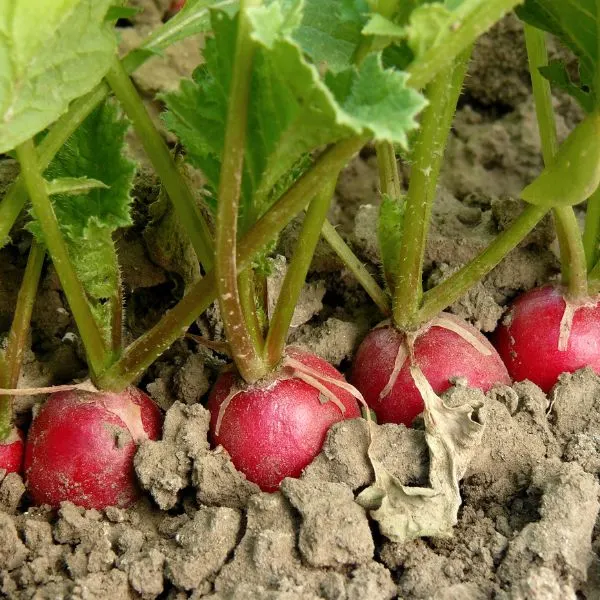
A radish is a root vegetable also belonging to the biological family Brassicaceae, the cabbage family. Its roots are edible and so are the leafy greens atop them. They may be eaten raw, which they mostly are, or cooked.
Radishes are also root vegetables and they mature quickly. Sweet potatoes are known to grow well with other root crops, and because they mature so quickly, your radishes can grow and be harvested before sweet potatoes need more growing space.
14. Turnips
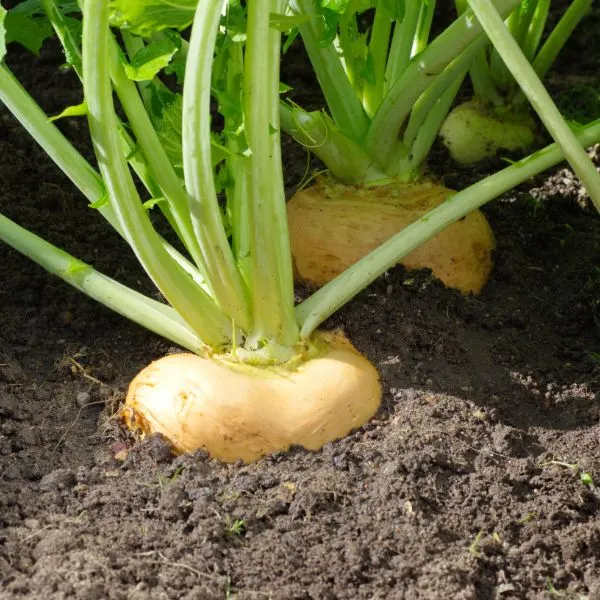
A turnip or white turnip is a flowering plant in the cabbage family Brassicaceae. This root vegetable is commonly grown in temperate climates worldwide for its edible, white and fleshy taproot which may be eaten raw or cooked.
Turnips are good companion plants for sweet potatoes. They are able to keep some pests away from your garden and control some diseases by releasing biotoxins into the soil. They are also able to capture nitrogen from the soil after harvest.
It is however not advisable to plant several brassicas in one area of your garden. Planting them together attracts similar insects and pests, and it drains the soil of nutrients since most are heavy feeders.
Flowers
Flowers like sweet alyssum and marigolds are not just visually appealing but also attract parasitic and predatory wasps, making them some of the best companion plants for a sweet potato garden. Their presence in the border areas of your sweet potato patch can significantly reduce pest infestations, ensuring a healthy crop growth.
15. Alyssum

Alyssum is a plant with a sweet scent likened to that of honey. Its beautiful and small flowers are brightly colored, usually in any shade of white, cream, pink or light purple. It is a good companion plant for sweet potatoes.
This plant draws beneficial insects to your plant while also keeping harmful ones away. It reduces the infestation of aphids by drawing in insects like ladybugs and parasitoid wasps to prey on them.
In addition, alyssum attracts bees to sweet potatoes and they help with pollination. This way, it is able to improve the yield of your crop.
16. Marigolds
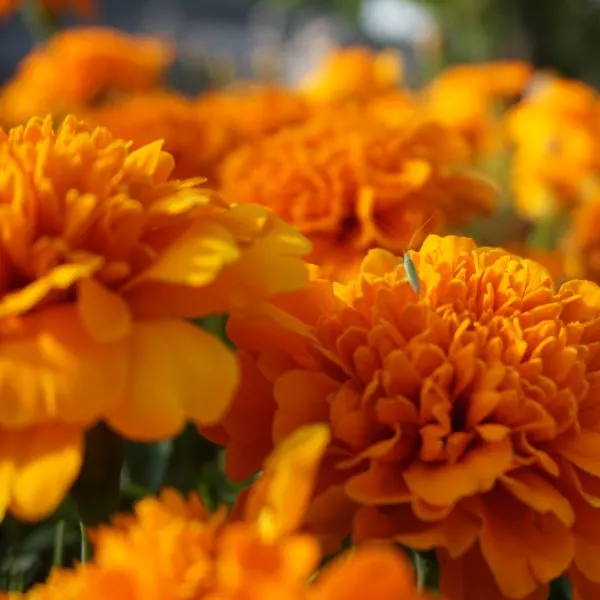
A marigold is any species of herbaceous flowering plants in the genus Tagetes of the aster family Asteraceae. The plant has green, pinnate leaves and brightly colored flowers. Its very beautiful flowers may be yellow, white, orange or golden.
These flowers attract beneficial insects like hoverflies, lady beetles, minute pirate bugs and parasitoid wasps. The joint efforts of these pest predators helps control the spread of aphids, caterpillars and thrips.
French marigolds specially help control nematodes within the soil that can cause root knot too. They also serve as trap crops. Marigolds are good companion plants for sweet potatoes.
17. Nasturtiums
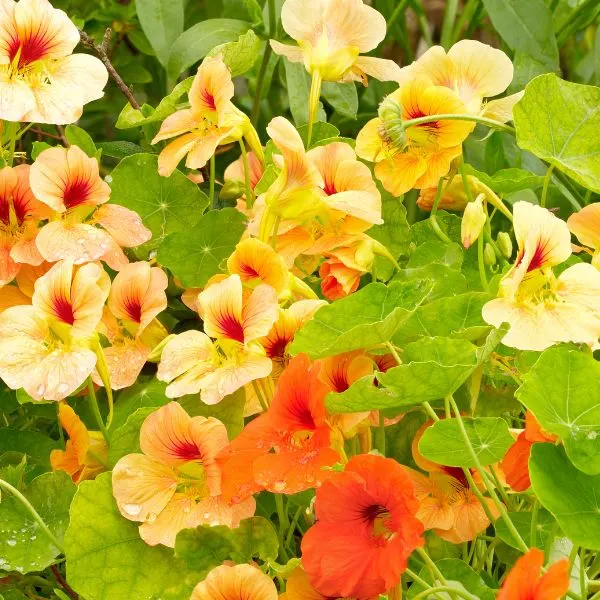
Also known as tropaeolum, nasturtium is a genus of plants that contains several creeping herbaceous plants which may be annual or perennial. These plants have showy round flowers and may be used in herbal medicine or cooking.
Nasturtium is another very suitable companion plant for sweet potatoes. It is a natural, effective pest deterrent, as it repels several pests, including aphids. It also serves as a trap crop by attracting some other pests to itself.
It can attract predatory insects and pollinators such as bees, butterflies, hoverflies, ladybugs and parasitoid wasps with its beautiful, vibrant red and orange flowers.
18. Yarrow
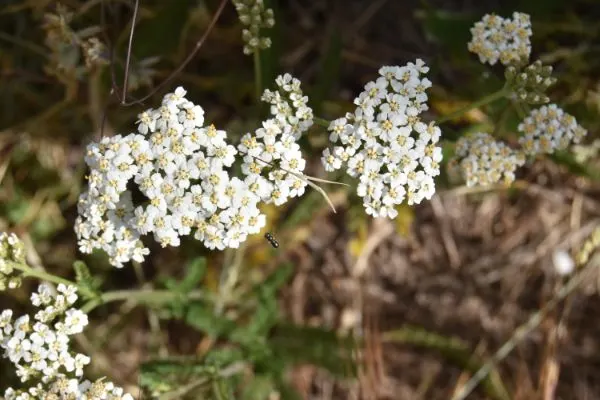
Also known as old man’s pepper, sanguinary, devil’s nettle, soldier’s woundwort or common yarrow, yarrow is a flowering herb in the aster or daisy family Asteraceae. It has a sweet scent and its flowers may be white, yellow, pink or red.
This plant is another good companion plant for sweet potatoes. Its flowers attract pollinators such as bees, beetles and butterflies which aid pollination.
They also attract predatory insects like braconid wasps, chalcid wasps, damsel bugs, green lacewings, hoverflies, ladybugs, pirate bugs, parasitoid wasps and robber flies.
Herbs
Aromatic herbs are excellent companion plants for sweet potato vines, as they repel common garden pests while attracting beneficial insects, contributing to a robust and aromatic vegetable garden.
19. Basil
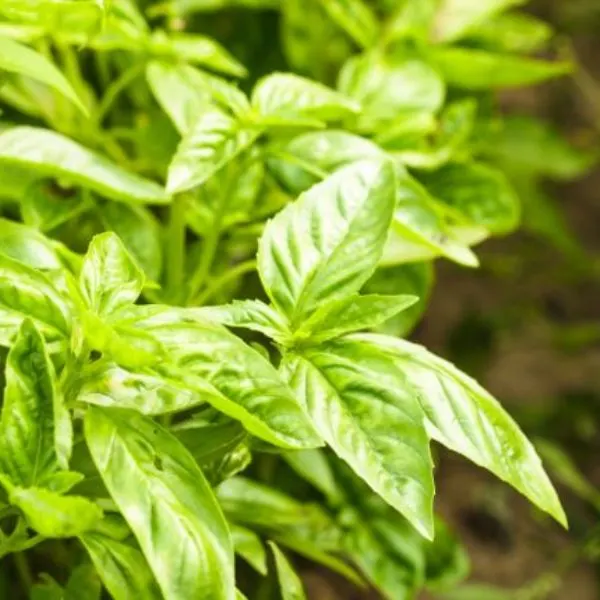
Basil is a culinary herb belonging to the mint family. Also referred to as great basil, it has a sweet, spicy and slightly peppery flavor. This tender plant makes a very good companion for sweet potatoes in the garden.
One benefit of planting basil with sweet potatoes is that basil attracts beneficial insects to your garden. Butterflies and a number of other insects that aid pollination or eat harmful crop pests are attracted to this plant.
Basil is also repellent to several harmful insects. It deters several pests like aphids, beetles, hornworms and whiteflies from your sweet potatoes and other plants.
20. Borage
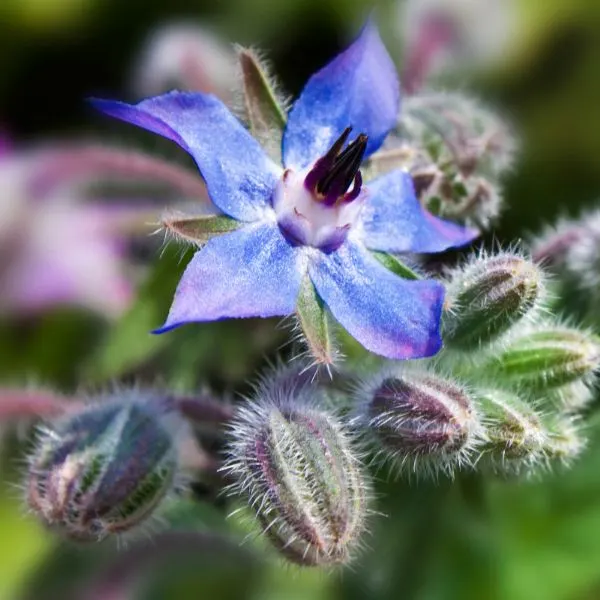
Also known by the name starflower, borage is an annual herbaceous flowering plant in the family Boraginaceae. This plant has complete flowers with five narrow, triangularpointed petals. These are predominantly blue but also occur in white and pink.
Borage is another plant that can aid pollination because it attracts lots of bees and other pollinating insects to your garden. In the same vein, it can help protect your sweet potatoes from the infestation of several pests.
This plant is also known to use its deep taproots for the benefit of plants near it. Borage can bring up minerals and water from deep within the soil to make them accessible to nearby plants, while also building calcium within the soil.
21. Catnip
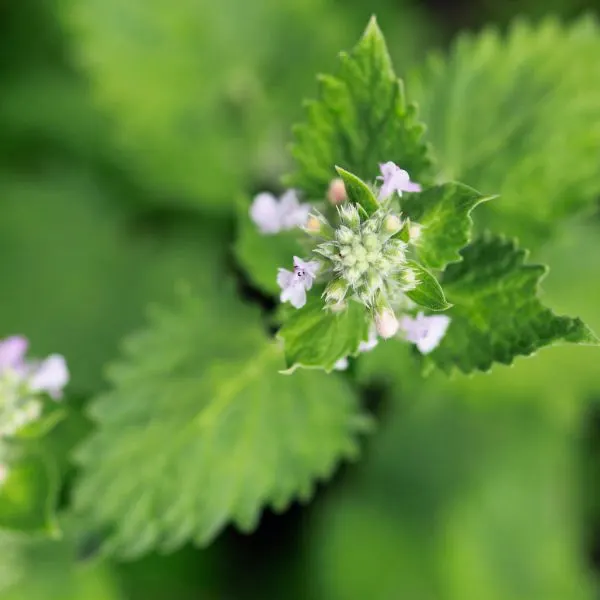
Known by other names like catmint, catnip, catswort and catwort, catnip is a species of flowering plants in the family Lamiaceae, the mint family. It is used to make tea and for cats, which have a hyperactive reaction to it.
Catnip is another good companion plant for sweet potatoes. It is an aromatic plant and is great for repelling pests. Some insect pests like aphids, beetles and cabbage worms and some rodents like mice can be kept away.
This flowering plant also attracts pollinators like butterflies to the garden. With catnip near your sweet potatoes, pests are kept away, beneficial insects are attracted; this makes for better harvest.
22. Dill
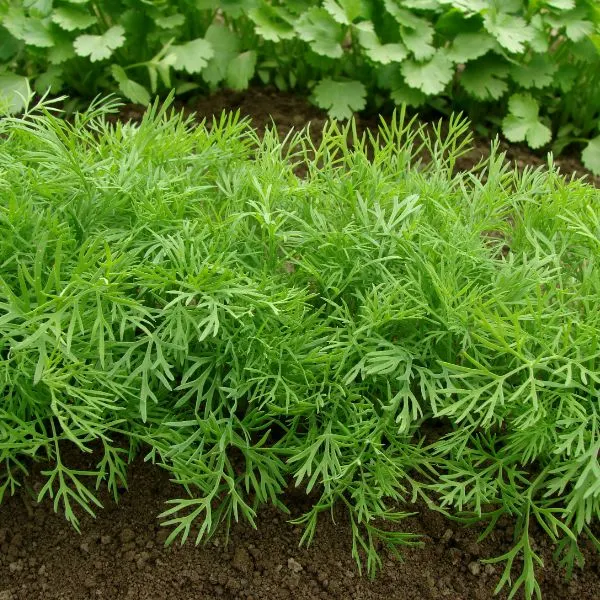
Dill is an annual herb in the celery family cultivated for its leaves and seeds. These may be used as herbs or as food seasoning. Dill is another example of good companion plant for your sweet potatoes.
It draws pest predators and other beneficial insects to the area and has deep taproots that break up the soil, reducing the chances of weed growth. Its strong scent can also keep pests away. Dill is a low-maintenance plant that is easy to grow.
23. Oregano
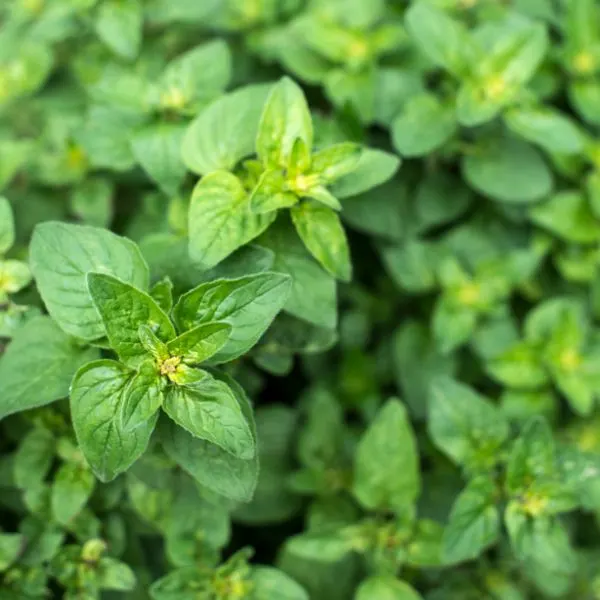
Oregano is a woody flowering perennial plant in Lamiaceae, the mint family. Also called origanium or wild marjoram, it is an aromatic woody plant with beautiful purple flowers. It may be harvested after a growing season but its flowers may not have bloomed yet.
When allowed to blossom, the beautiful flowers of the oregano plant draw several beneficial insects to your garden. They may be agents of pollination, like bees and butterflies.
These beneficial insects could also be predatory ones like lacewings and ladybugs that feed on crop pests. It also has a strong smell that can keep pests at bay and is a fairly easy plant to take care of.
24. Summer Savory

Summer savory is an annual plant in Lamiaceae, the mint family. With slender, bronze-green leaves, the flowering herbaceous plant has lilac tubular flowers that are very beautiful when they are in bloom.
The aromatic plant can repel harmful insects, cabbage moths and spider mites for example, while also attracting beneficial insects which may be pollinators or pest predators. It is a good companion for sweet potatoes.
25. Thyme

Thyme is another aromatic evergreen herbaceous plant in the mint family Lamiaceae. It is a perennial flowering plant closely related to oregano and summer savory. This herb is also a good companion plant for sweet potatoes.
It provides ground cover, deters pests from the garden and attracts pollinating insects to your plant. It keeps your plant cool and prevents weeds from growing. Thyme has antifungal properties so it can prevent damage to your sweet potatoes.
Legumes
26. Bush Beans
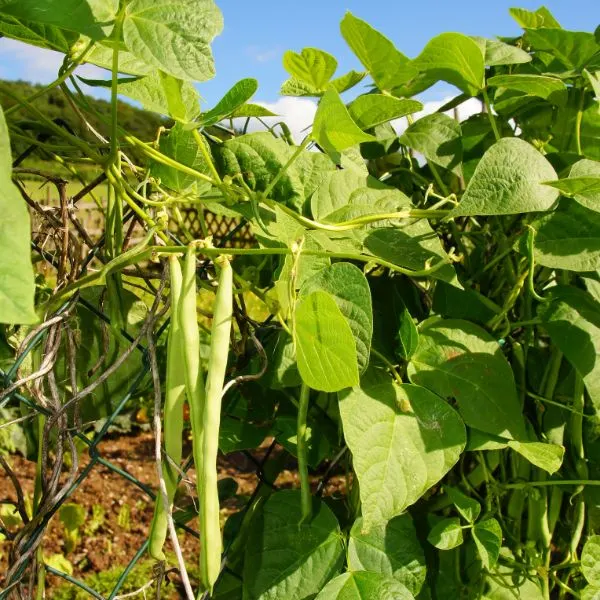
Beans are seeds of several genera of flowering plants that belong to the botanical family Fabaceae. The seeds are then boiled, fried, baked or cooked by some other method and used as vegetables for humans or animals to eat.
You can plant the more compact variety of beans called pole beans near your sweet potatoes to avoid blocking them from sunlight. Beans are good companion plants for sweet potatoes because they are legumes.
Legumes have nodules in their roots that help fix nitrogen in the soil. They improve the quality of the yield of other plants, provide good ground cover in your garden (preventing water loss and weed growth) and attract pollinators.
27. Lentils
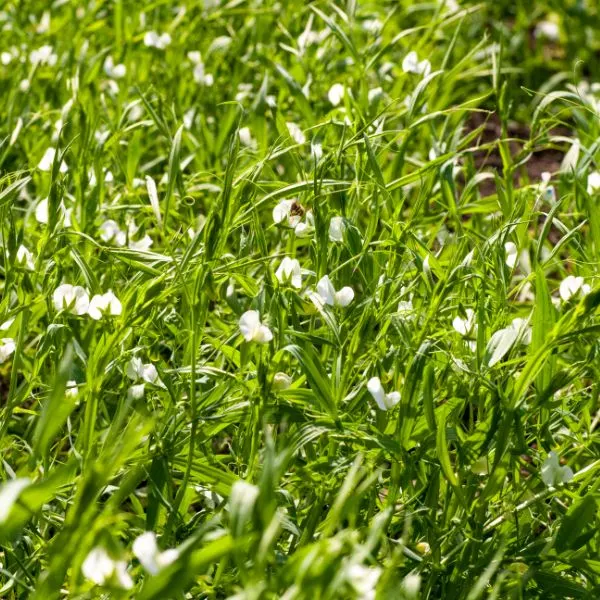
Lentil is yet another leguminous plant in the biological family Fabaceae which serves as a good companion for sweet potatoes. The annual plant produces edible, lens-shaped seeds that grow in pods.
The tall growing legume first serves as a nitrogen fixing plant before it is mulched. It can help restore and renew depleted nutrients in poor soils. Of course, the result of this is better crop yield.
Lentils also serve as good ground cover, slowing down the rate of erosion, retaining water in the soil and preventing weeds from growing After growing lentils, you can mulch them.
28. Peas
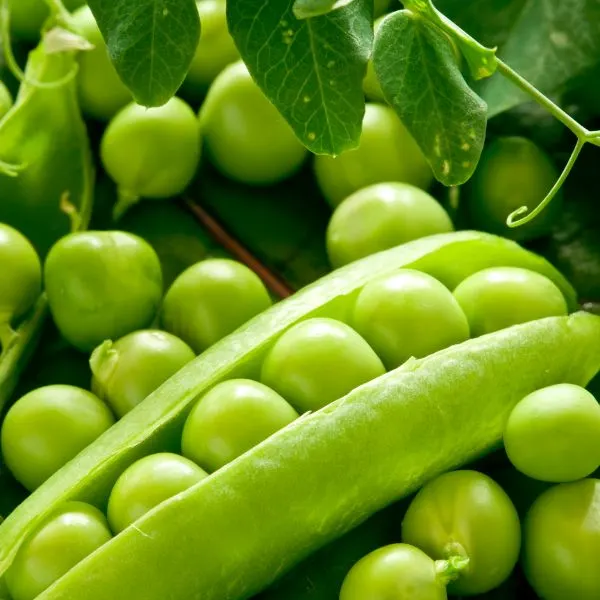
Peas are herbaceous flowering annual plants in the same biological family as beans, Fabaceae. Also known as garden peas, these plants are cultivated in various parts of the world for their edible seeds.
Like beans, they are leguminous plants, with nodules in their roots that help fix atmospheric nitrogen in the soil. They replenish used up nutrients in the soil so they are very crucial and effective for moderate to heavy feeders like zucchini.
Peas improve the quality of the yield of other plants, zucchini in this case, because they supply nutrients to the soil. They also maximize space in your garden and serve as mulch when they die.
29. Pole Beans
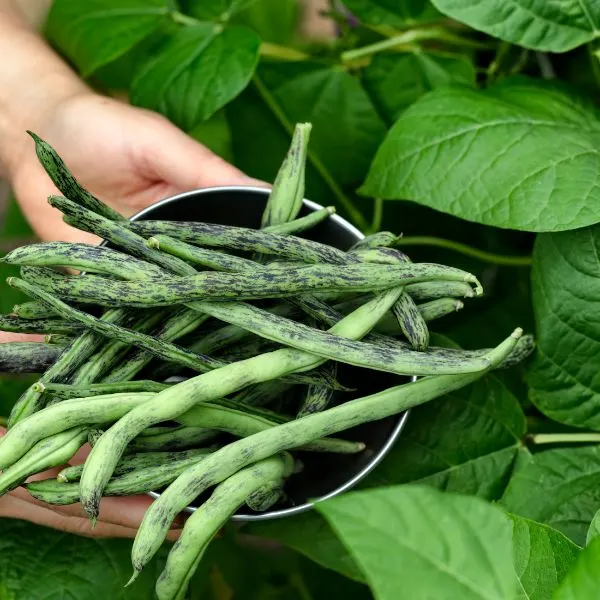
Beans are seeds of several genera of flowering plants that belong to the botanical family Fabaceae. The seeds are then boiled, fried, baked or cooked by some other method and used as vegetables for humans or animals to eat.
You can plant the taller variety of beans called pole beans with your sweet potatoes as well if they are trained to grow on the ground. The beans can protect them from excessive exposure to sunlight and also help fix nitrogen in the soil.
Pole beans also provide good ground cover in your garden. This prevents the water loss that results from evaporation and reduces the growth of weeds. Also, their flowers attract even more pollinators to the garden.
Root & Salad Vegetables
30. Parsnips
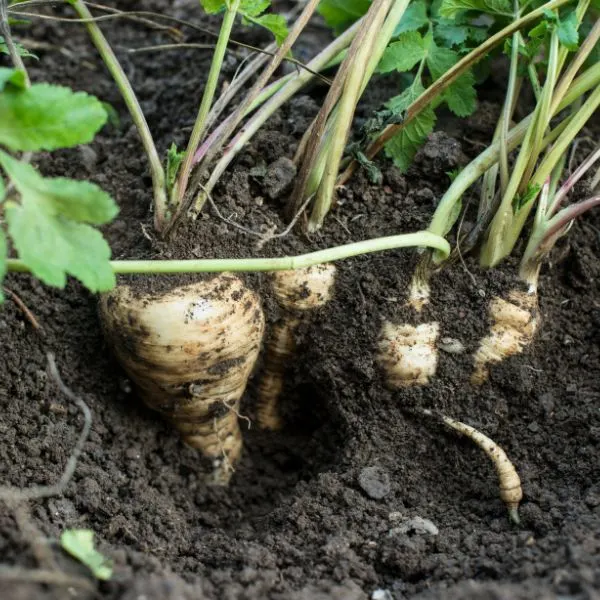
A parsnip is a flowering plant in Apiaceae, the carrot family. It produces an edible root vegetable related to and resembling carrots. The harvested root is usually cream colored with leafy greens above it.
Parsnips attract predatory insects that feed on several crop pests, protecting the plants around them. The pest predators can ensure that the infestation of these sweet potato pests is significantly reduced in the garden.
To further combat pests, the roots of these plants produce a substance that is toxic to several insects and disease causing agents that could adversely affect sweet potatoes and nearby plants.
31. Potatoes
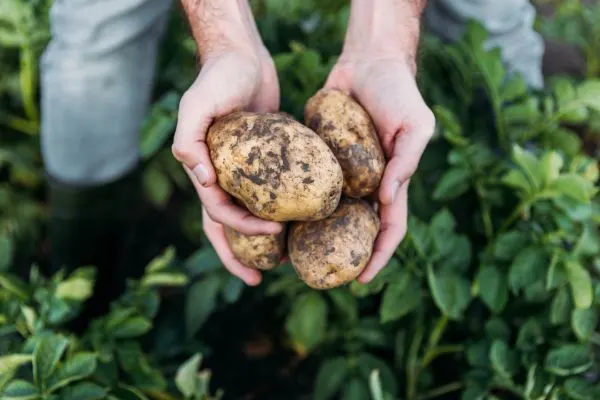
Potatoes are members of the nightshade family Solanaceae, like eggplants and peppers. They are perennial plants grown as root vegetables. These starchy tubers primarily contain carbohydrates, protein and fiber, with very little fat content.
Unlike these other members of their family, potatoes are good companion plants for sweet potatoes. They are also root vegetables and so they tend to enjoy growing conditions like those sweet potatoes enjoy.
Planting potatoes and sweet potatoes together turns out to be a good practice that does not necessarily benefit both plants but is comfortable for them.
32. Spinach

Spinach is a flowering plant in Amaranthaceae, the amaranth family. Its green leaves are edible and commonly eaten as a vegetable either raw or after preservation. Spinach is a good companion plant for sweet potatoes.
These plants do not compete because spinach has shallow roots. Also, spinach serves as a good ground cover, filling holes within your garden and preventing water loss in the soil. This maximizes the potential and space of the garden.
Spinach helps with weed control within the area. This plant matures quickly so it can be harvested before your sweet potatoes need more space to spread and grow bigger.
Bad Companion Plants for Sweet Potatoes
Cucurbits
1. Cantaloupes
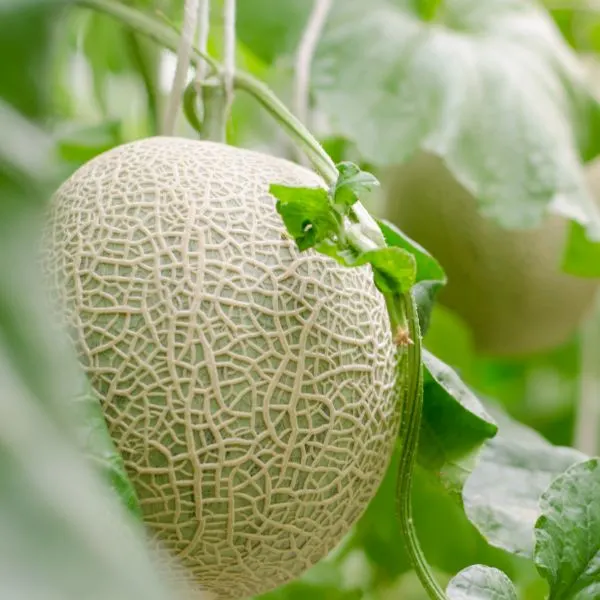
Cantaloupe is also known as rockmelon, spansek or sweet melon. It is a variety of a species known as muskmelon within the cucurbit or gourd family Cucurbitaceae. It is a summer fruit that comes in several sizes and weights.
Cantaloupes are vining heavy feeders that love sunlight. They are not good companion plants for sweet potatoes, much like moist members of their family.
Growing these plants side by side to may result in the cantaloupe’s crowding out or choking your sweet potatoes. This competition for space, nutrients, water and sunlight will most likely lead to low yields in your sweet potatoes.
2. Cucumbers
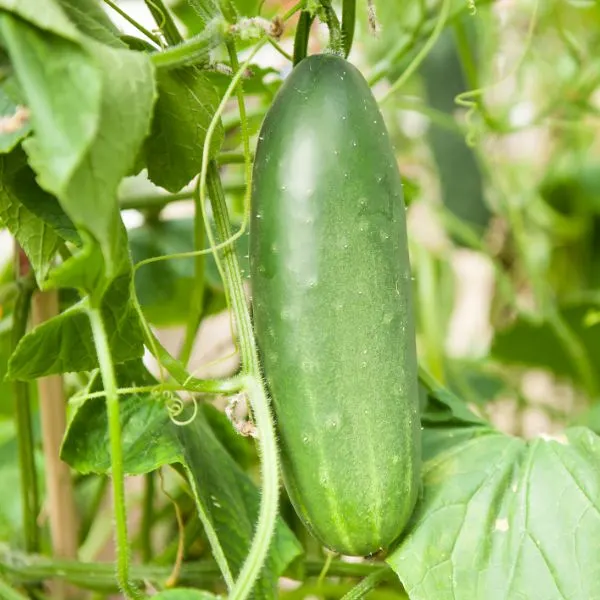
The cucumber plant is a creeping vine in the cucurbit family Cucurbitaceae that bears cylindrical fruits which are used as vegetables for culinary purposes or eaten raw. It is one of the cucurbits that serve as good companion plants for spinach.
This is another bad companion plant for sweet potatoes. It is not advisable to plant crops within the melon family near your sweet potatoes.
Your sweet potatoes need exposure to lots of sunlight, and cucumbers love the sun. They also needs lots of water, so these conditions may cause them to compete. Cucumbers may choke sweet potatoes out or reduce plant yield.
3. Pumpkins
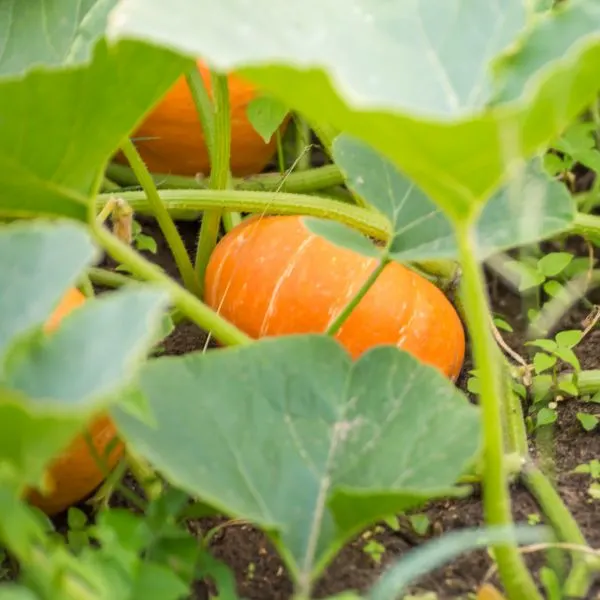
The pumpkin is a coarse vining plant widely cultivated for the fruit it produces. This pumpkin fruit is a large pulpy round fruit with firm orange skin and numerous seeds. This plant is also in the gourd family Cucurbitaceae.
Pumpkins are bad companion plants for sweet potatoes. They tend to compete aggressively with your root tubers for sunlight, water, nutrients and space. They can choke out your sweet potatoes.
4. Squashes

Squashes are herbaceous vegetables in the Cucurbitaceae family, the gourd family. This genus comprises many different species grown to be consumed as vegetables. They are very bad companion plants for cantaloupe.
These plants have long taproots but the rest of their roots are short. As a result, they need constant water supply in order to grow and maximize yield. They also enjoy full sunlight for about 6 hours daily to develop properly.
Squashes take up lots of soil nutrients, need adequate space to sprawl and love lots of sunlight. Growing them with sweet potatoes results in unhealthy, avoidable competition and the infestation of several similar pests.
5. Watermelons
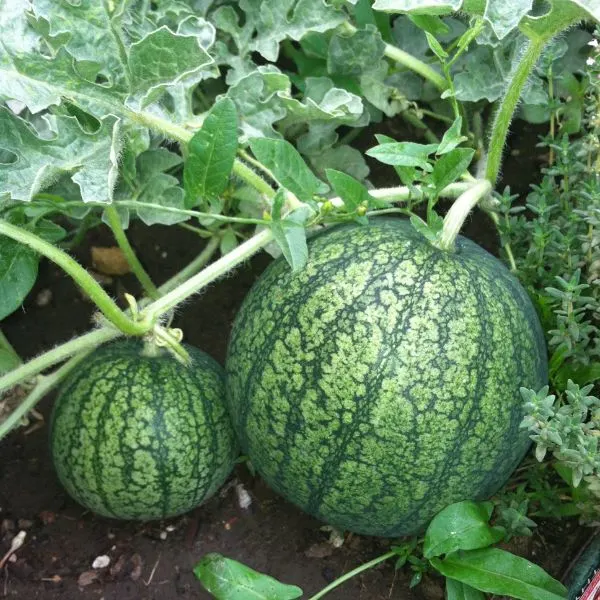
Watermelon is the name of a flowering plant species which belongs to the gourd family Cucurbitaceae and the name of the edible fruit that the said plant produces. There are over a thousand varieties or cultivars of this popular plant.
Just as other plants within its family, the watermelon is a scrambling, sprawling or trailing plant. Its fruit has a sweet and juicy flesh that is usually deep red to pink with lots of black seeds. It may be eaten raw or pickled.
Do not plant watermelons beside sweet potatoes. The melon plant hinders the growth of the other one. Watermelons also compete for sunlight, space and nutrients with your sweet potatoes and they are attacked by some similar pests.
Nightshades
6. Eggplants
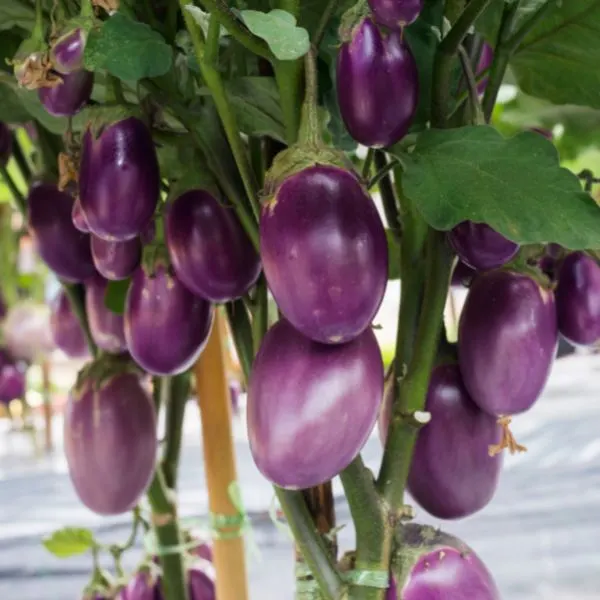
Eggplant, aubergine, or brinjal is a vining flowering plant in the nightshade family Solanaceae grown worldwide for its edible, spongy and mostly purple fruit. This fruit, also called eggplant, is used in various cuisines as a vegetable.
Nightshades also tend to be heavy feeders that need ample space to grow. This may results in problems of space between these crops. Eggplants grow tall too, so they may shade your sweet potatoes too much from the sunlight.
7. Peppers
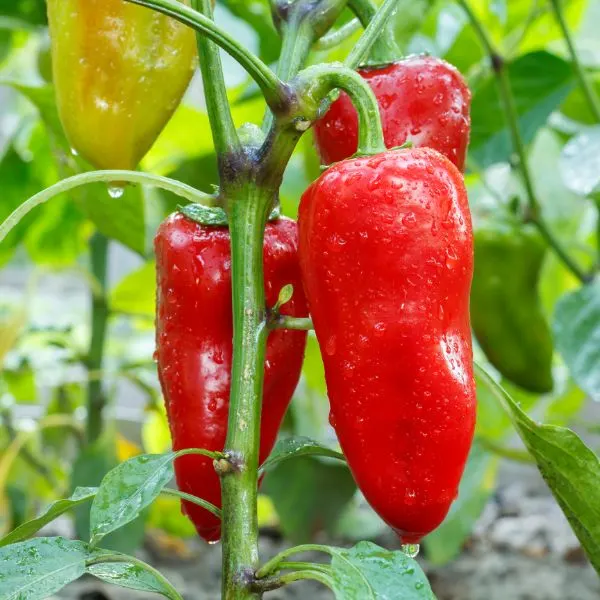
Like eggplants and tomatoes, pepper plants are flowering plants of the nightshade family. Several species and cultivars exist, even in various colors like red, yellow, orange, green, white and purple.
Peppers should not be planted in close proximity to your sweet potatoes. This is because both plants tend to compete for nutrients with each other, peppers may take up too much sunlight and both could fight for space.
Both sweet potatoes and pepper plants are susceptible to attacks from aphids, flea beetles and spider mites. For this reason, it is not advisable to grow them side by side in the same soil.
8. Tomatoes
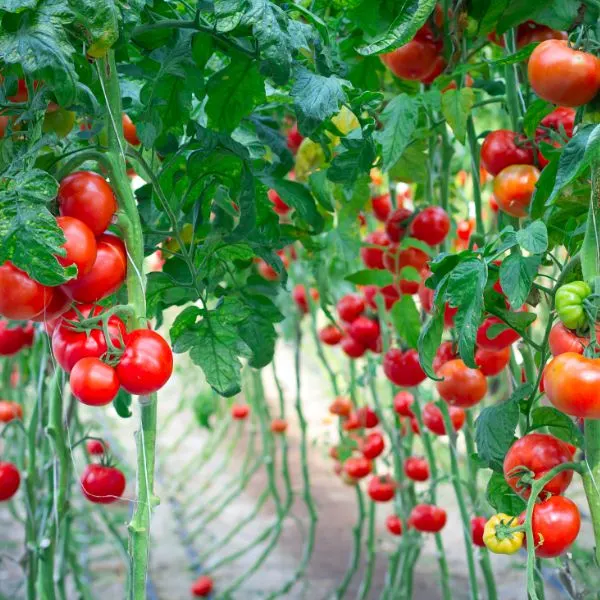
Tomatoes are South American plants of the nightshade family Solanaceae. They produce a widely grown mildly acidic fruit also known as tomato, with many varieties. Tomatoes are a glossy red or yellow color, pulpy and edible, eaten raw or cooked.
As nightshades, they are also very bad companion plants for Brussels sprout is tomato. Planting tomatoes and Brussels sprouts side by side can cause harm to both plants. Brassicas generally stunt the growth of tomatoes with their own allelochemicals.
Like plants in the Brassicaceae family, tomato is a heavy feeder. It needs a lot of water, nutrients and care for the best results. Placing these two crops beside each other makes them compete for nutrients.
A competition for nutrients will result in one or both of the plants being stunted. The crops are not allowed to grow and produce to their full potential. So for the best results, keep tomatoes and Brussels sprouts far apart.
Others
9. Fennel
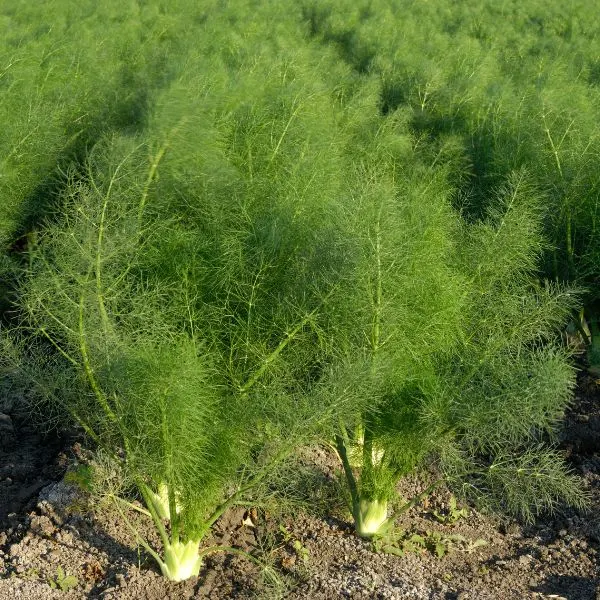
Fennel is a species of flowering plants in the carrot family. This hardy, perennial herb has yellow flowers and feathery leaves. It is yet another bad companion plant for zucchini, as it contains allelochemicals.
Allelochemicals are biochemicals that influence development processes like germination, growth, survival and reproduction of other organisms. Fennel can inhibit and stunt the growth of zucchini and many other garden plants.
10. Sunflowers

A sunflower is any species of annual and perennial plants that belong to the genus Helianthus in the family Asteraceae, the daisy family. They bear flowers which have large heads, dark disk florets and flamboyant yellow rays.
Do not plant sunflowers beside your kale. The moisture needs of these plants are quite different. Sunflowers prefer dry soil over wet soil although they tolerate moisture in well drained soil.
Sunflowers are susceptible to attacks from several plant pests that could also harm your kale, including curculios and snout beetles. Keep these plants away from each other.
Printable infographic
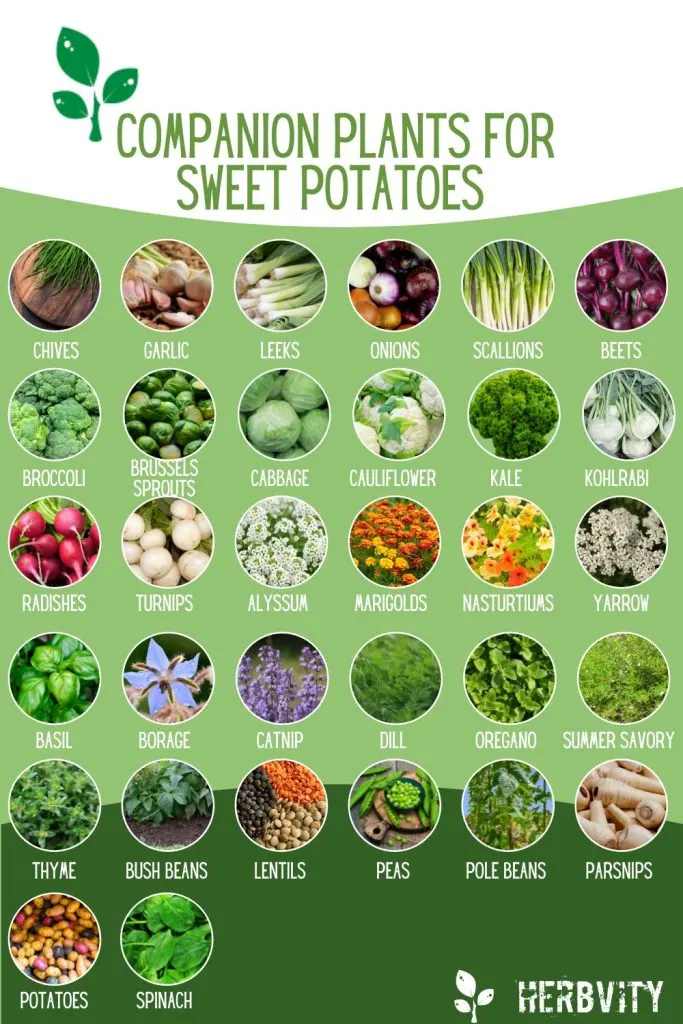
FAQs
What grows well with sweet potatoes?

Beans, corn, and squash grow well with sweet potatoes, as they help maximize space and provide beneficial interactions in the garden.
What not to plant next to potatoes?
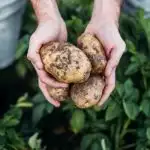
Avoid planting tomatoes, eggplants, and peppers next to potatoes, as they belong to the same family and can share common pests and diseases.
What do sweet potatoes need for fertilizer?
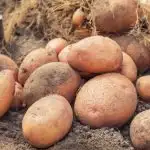
Sweet potatoes need a balanced fertilizer, such as a 10-10-10 or 14-14-14 mix, applied at planting and during the growing season to ensure optimal growth and yield.
Can you plant carrots with sweet potatoes?

Yes, you can plant carrots with sweet potatoes. They have different growth habits and root structures, which allows them to coexist well in the same garden bed. Additionally, carrots help to break up the soil, which can be beneficial for the development of sweet potato tubers.
Can you plant potatoes and sweet potatoes together?
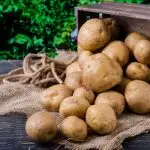
It’s generally not recommended to plant potatoes and sweet potatoes next to each other, as they can attract similar pests and diseases.
Can you plant sweet potatoes next to peppers?
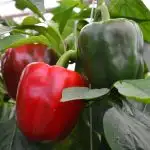
Yes, you can plant sweet potatoes next to peppers. Both plants have similar growing conditions, such as warm temperatures and well-drained soil. This companion planting can be beneficial, as sweet potatoes can act as a ground cover, helping to suppress weeds and maintain soil moisture for the peppers.
What to plant after sweet potatoes
Here are 5 types of plants that can be planted after sweet potatoes that will help keep the soil healthy.
1. Legumes
Legumes, such as peas and beans, are nitrogen-fixing plants that can help replenish the soil after sweet potatoes, which are heavy feeders.
2. Brassicas
Cabbage, broccoli, cauliflower, and other brassicas benefit from the nutrient-rich soil left behind by sweet potatoes.
3. Leafy greens
Spinach, lettuce, and kale can be planted after sweet potatoes, as they have different nutrient requirements and help with crop rotation.
4. Root vegetables
Planting root vegetables like carrots, beets, and radishes after sweet potatoes can help break up the soil, improving its structure for future crops.
5. Alliums
Onions, garlic, and leeks are good choices for planting after sweet potatoes, as they have different pest and disease profiles and can help maintain soil health.
Conclusion
Incorporating great sweet potato companion plants into your garden is not just about achieving a bountiful harvest; it’s also about embracing sustainable gardening practices. From cover crops that enrich the soil to aromatic herbs that keep pests at bay, each plant plays a crucial role in the ecosystem of your garden. As you plan your spring garden, consider these companions to ensure your sweet potatoes and their neighbors thrive together, paving the way for a harvest that’s both plentiful and rewarding.
Some health benefits of eating sweet potatoes include the provision of fiber, vitamins and minerals, aid to the immune system, encouragement of good eyesight, promotion of digestive health and improved brain function.
The edible root tubers that these are about 76% water, 21% carbohydrates and 2% protein, with their fat contents very little. They are also rich in vitamins and minerals.
They provide the body with vitamins A equivalent, B1 (thiamine), B2 (riboflavin), B3 (niacin), B6, B9 (folate), C and E, and the minerals calcium, iron, magnesium, manganese, phosphorus, potassium, sodium and zinc.
While growing sweet potatoes, remember that they need exposure to full sun, well-drained, consistently moist soil with pH of between 5.5 and 6.5, steady and even levels of moisture and loose, sandy or fine loamy soil for the best or optimal results.
More companion plants
